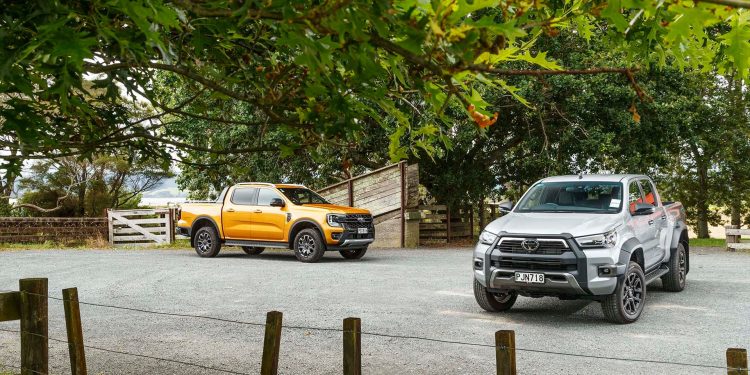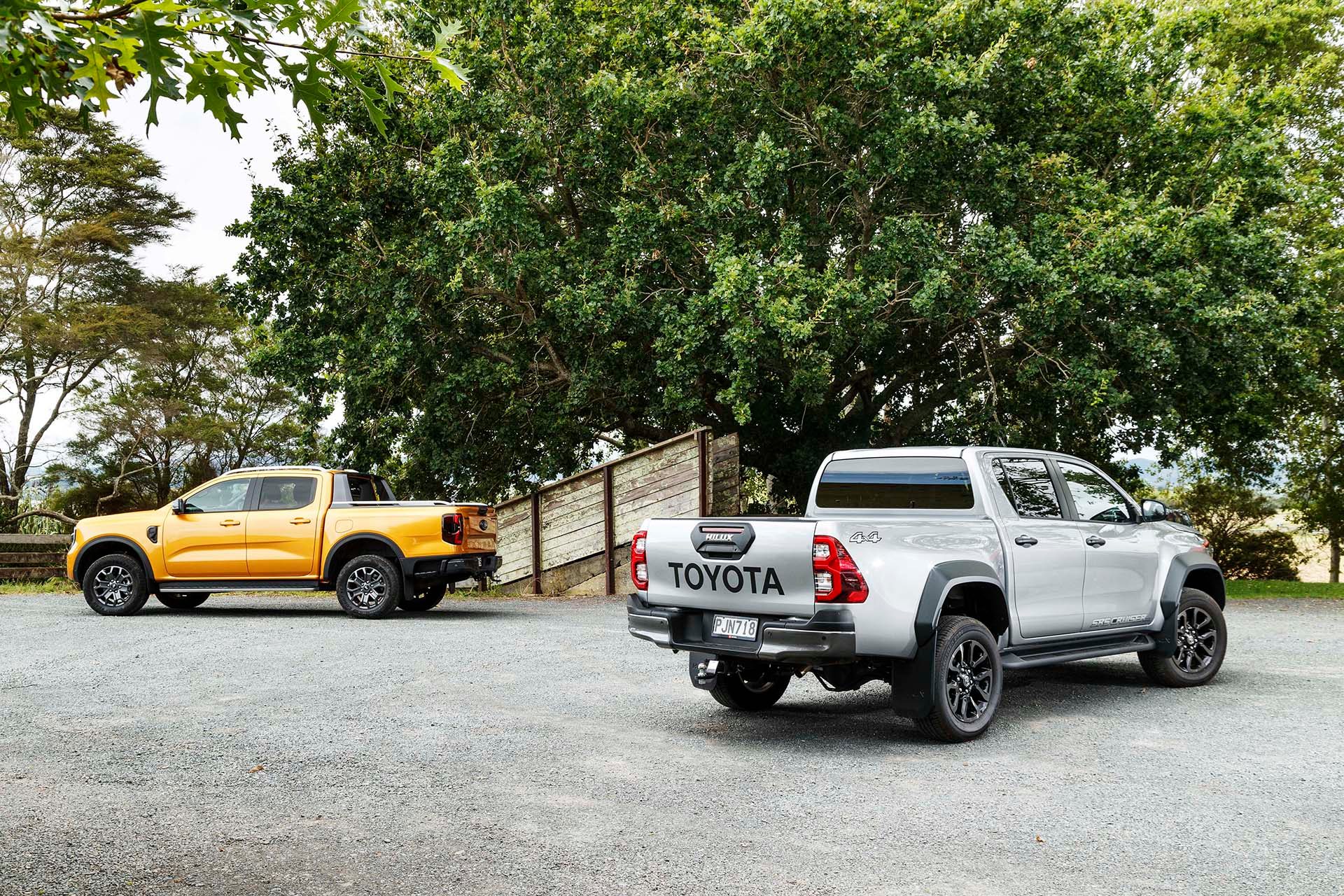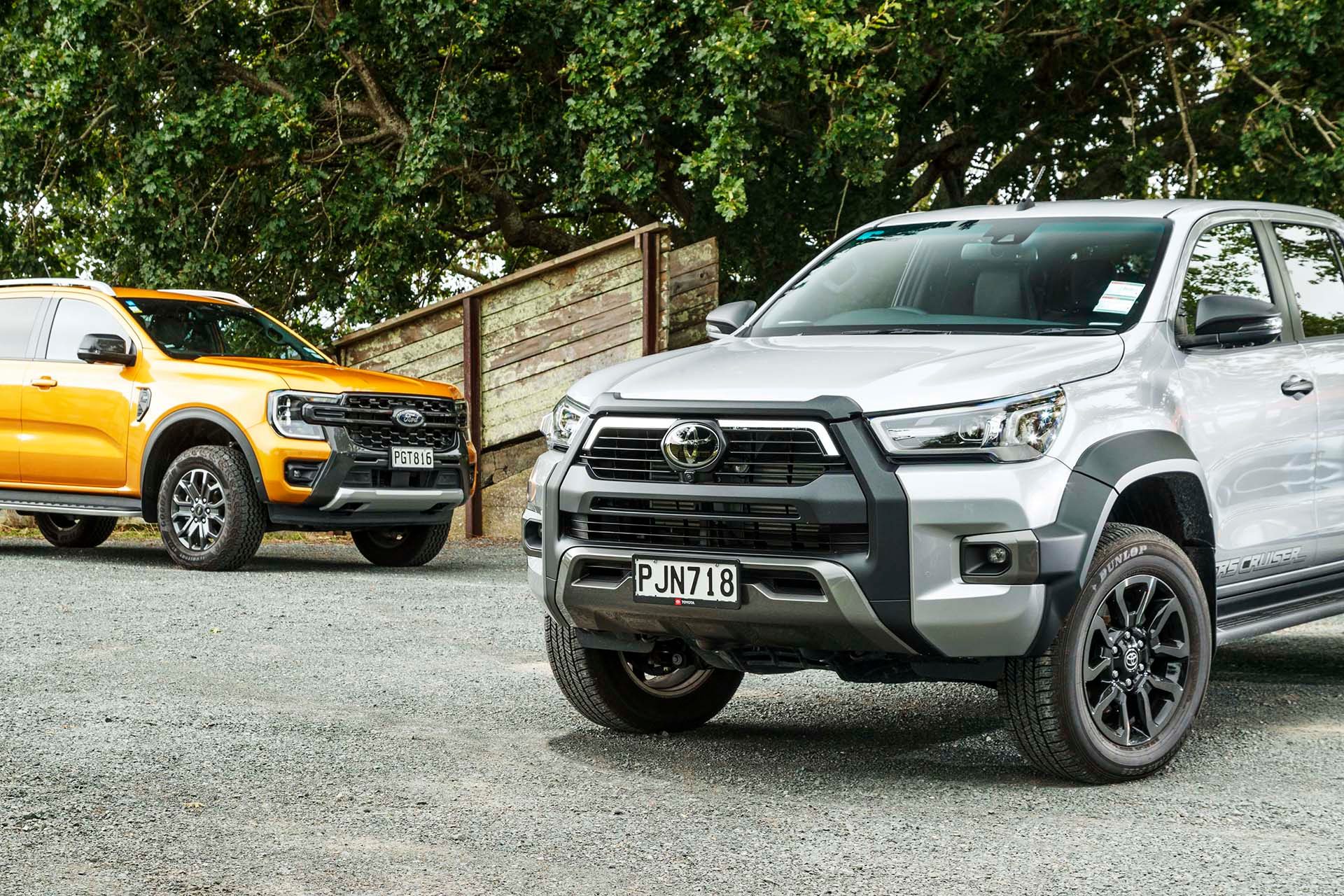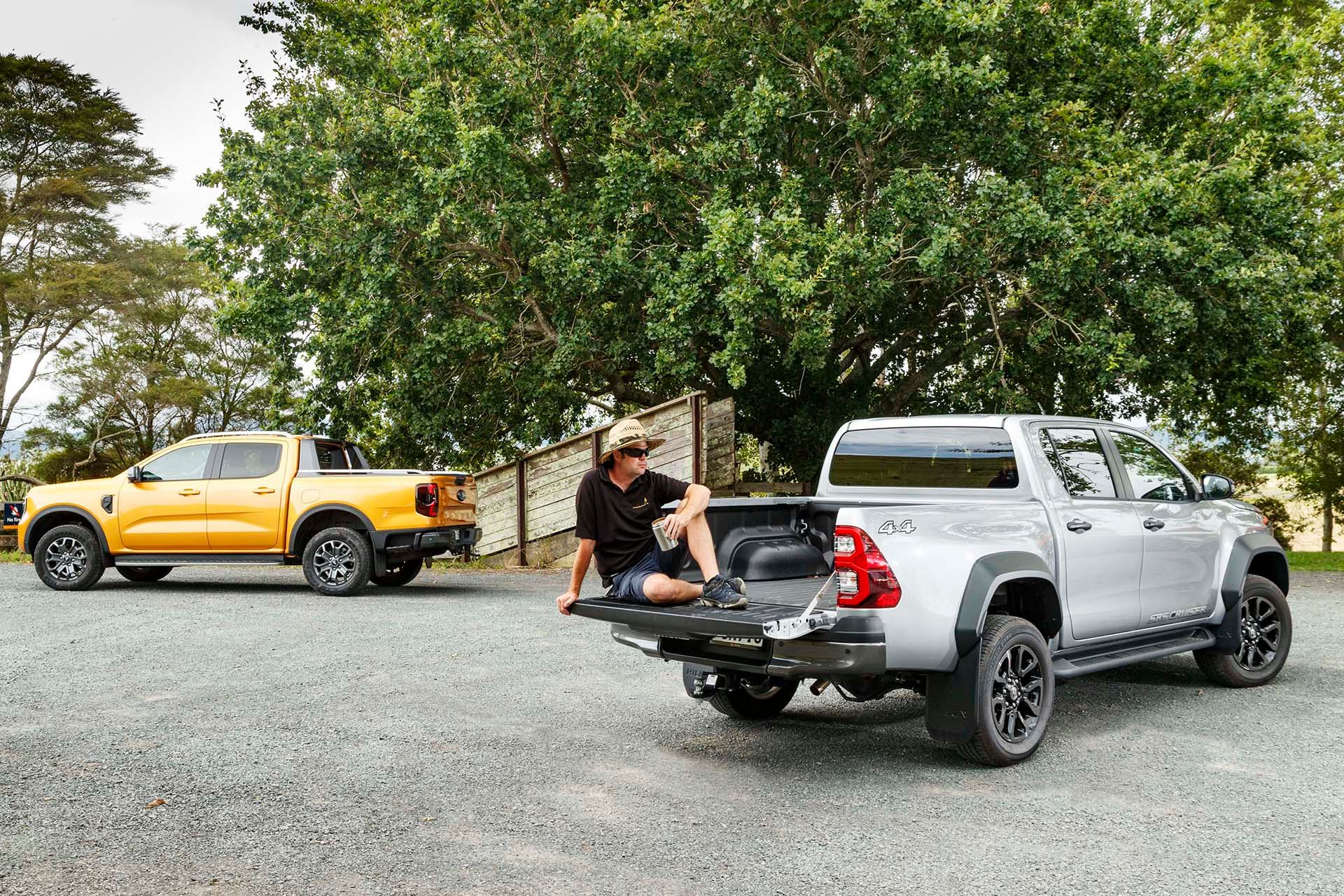Buying guide
2023 Ford Ranger Wildtrak vs Toyota Hilux SR5 Cruiser comparison review
Toyota’s Hilux and Ford’s Ranger are the two top dogs in the ute arena but one is younger, leaner and meaner.
Despite the best efforts of Government policy, these two commercial vehicles, the Toyota Hilux and the Ford Ranger, continue to top the sales charts. Some ute nameplates have fallen on tough times, sales figures dipping dramatically after Clean Car fees, or the ute tax, came into effect. But not these two, both with a waiting list for some models, such is the fervour for these trucks. Most ‘do the mahi’, the double-cab ute favoured for its ability to work during the week and play on the weekend, or so the marketers tells us. Many other owners just cruise around with not much in the tray and just themselves in the cab. But now, all ute buyers pay the fee for the privilege, helping fund all those rich people into a new Tesla, or so we are told by the opposition.
Ranger has recently renewed, and the only truck to challenge it is the Hilux. Top spec utes remain popular, (what’s a few thousand more dollars in fees really?) and so we’ve got the Wildtrak together with the new ‘widetrack’ SR5 Cruiser. Which of these utes really rules the roost?
The specs please
We have the bi-turbo Wildtrak here to match the cylinder count of the Hilux (which doesn’t offer a V6 alternative like Ranger), and both front with similar numbers from their diesel donks; 154kW/500Nm from the Ford and 150kW/500Nm from the Toyota. That’s despite its 2.8-litre having an 800cc advantage over the Ford. The Hilux also runs a six-speed auto to the Ford’s 10-cog unit. With a smaller engine and greater gear count, the Ranger has the better fuel use figure of 8.3L/100km. It gets a bit confusing in terms of CO2 output, for those Wildtrak’s fitted with stop and go are rated at 218g/km with a fee of $1840. For those without, it’s 231g/km and a fee of $2587.50.
Figures for the SR5 Cruiser read 9.5L/100km and 252g/km which equates to $3795 in fees. While there is a six-month wait for the Hilux, Ford currently has a good supply of Wildtrak ready for delivery.
Both have the ‘old fashioned’ switchable 4×4 set-up with 2- and 4-Hi, a low-range transfer case, rear diff lock and electronic hill descent control while the Ford also adds a few off-road terrain modes for the traction control.
There’s a discrepancy in pricing, the Toyota at $63,390 (the no-haggling, on-the-road price) while Ford asks $75,990 for a Wildtrak. It does however deliver more on the spec front, with the likes of a tow bar (circa $1500-$2000 extra for the Hilux buyer) and tray liner (another $830 on Lux) included as standard, along with its fancy electrically retractable lid (a hard lid adding between $4500 and $6500 to the Hilux). The WT also comes fitted with its sports bar and roof rails. There are also fancier items included with the Ford like self parking, better exterior lighting for when you’re ‘out there doing it’, an integrated brake controller for towing and other items we’ll mention later. We’ve bored you enough with a retelling of the spec sheets you can pore over online. In short, you pay a bit more for the Ford but you get more in return.
Hilux offers capped price servicing at $390 a pop; keep up the maintenance and you get another two years/50,000km on the standard 3yr/100,000km warranty, therefore matching Ford’s 5yr/150,000km cover.
Another Toyota Hilux update
The current generation of Lux dates way back to 2015, though it’s been updated numerous times since. And this ‘widetrack’ SR5 Cruiser is yet another. You’ll notice it looks a bit fatter around the flares, those add ons containing the 140mm increase in track. Wish they filled those arches with something a bit more up for it, as the standard alloys and rubber look underdone. The suspension changes are said to bring about both increased on- and off-road capability and stability. The front arms and roll bar were lengthened and the angle of the shockers altered while at the rear, the axle has been lengthened, a stabiliser bar fitted and the dampers pushed out further toward the wheels. Results are a claimed 20 per cent improvement in roll rigidity and improved steering feel. The brakes have also been upgraded with larger discs all round (so no drums on the rear of this Hilux). They also added a blind spot minder and rear cross traffic alert.
How does the Hilux go against Ranger though?
You notice that the 2.8-litre is noisier, with more vibration, at both idle and on the go. The Ranger’s powertrain is smoother, more refined while the auto shifts with more fluidity too. Neither has much turbolag off the line, both with a strong midrange. The Hilux pulls its ratios well but the quick acting trans in the Ford and its extra gears sees it haul that bit quicker. And yet it’s also easier on diesel use, the Ranger returning 9.5L/100km whereas Hilux was sitting on 10.9L/100km.
In terms of ride quality, the Ranger gives its occupants an easier time over the bumps, its rear end calming where the Hilux can fidget over the small ones, and gives the odd jolt over the harsher hits. It’s harder to turn the Hilux around with its bigger turning circle and heavier, slower steering.
Both handle smartly, the Ford more compliant with the road surface below but the Hilux does hold on better in the bends at the front end. Its more road friendly tyres help, as do the suspension changes, notably the rear stabiliser bar reducing the inclination of the rear to roll. This also gives the firmer steering more character; while it’s a bit slower to turn than the Ranger, there’s more of a connection.
On gravel trails, the traction control of the Hilux gets more of a work out in 2WD, the rear axle more likely to be bouncing about the place, so it benefits more from switching to 4-Hi. The stability and traction aids of the Ranger are superior, as you’d expect of the much newer truck.
What are the Ranger and Hilux like inside?
Step up into the cabin and Hilux is showing its age. Its screen now seems quaint, the small format does nothing for the low res image of the reversing camera and the sat nav map doesn’t show much of the surrounding area. Analogue dials for the speedo and tacho take up 80 per cent of the instrument binnacle, relegating trip info, safety gadget displays and other readouts to fight for time on the tiny screen between the gauges. Ranger meanwhile has a full digi dash, configurable to show as much or as little info as you desire.
There’s more hard, shiny plastic about in the Toyota and nothing like a charge pad or multiple USB-C plugs that the Ranger has. The Hilux does have a three-pin 220V plug for charging larger devices however. The Wildtrak’s big touch screen is supplemented by hard buttons for ventilation, while there’s superior (if not quite amazing) voice control too. The surround view and backing camera images fill the screen with a clear image so you can manoeuvre this about more confidently.
There are better storage solutions, and Ranger’s smart door releases really do make opening the door that much easier. The seats too are better padded for added comfort and offer better adjustment, as does the steering wheel. The electric park brake and auto hold function add convenience although hoons will prefer the Hilux’s manual handbrake when in the paddock.
There’s a couple of extra centimetres for knees in the rear of the Ranger, and better access through larger doors. Both have Isofix points and you can lift up the seat squab for secure cabin storage.
Up for hard work?
Hilux has the more useful tray dimensions, wider across the tailgate (134 cm versus 122) while the receptacle for Ford’s sliding tonneau cover eats up load space at the front of the tray. As a result, the Hilux deck is longer (150cm versus 130). The Ford’s tray comes with relocatable tie down points along the top, the step in the bumper gives you a boost to retrieve things more easily, and a helper spring makes light work of shutting the tailgate. The Hilux’s is much heavier so you might want to opt for the $350 tailgate assist with a gas strut that also eases it down. Ranger’s tailgate locks off the central locking, while the tonneau can also be retracted via the key fob. Both utes are rated to tow a max of 3500kg and each has a 350kg down weight.
Ford Ranger vs Toyota Hilux, which is better?
In these particular guises, the Wildtrak is the pick. It’s generally an easier thing to tool around in, has more features, drinks less dino juice and is more refined. The initial purchase price is higher, but you pay fewer fees, and once you add the usual towing and tonneau options to your Hilux, there’s not much in it which adds further weight to the Ranger’s cause.
| Model | Ford Ranger Wildtrak Bi-Turbo |
| Price | $75,990 |
| Clean Car Discount | Fee – $1840 |
| Engine | 1996cc, IL4, TDI |
| Power/Torque | 154kW/500Nm |
| Drivetrain | 10-speed auto, switchable 4×4 |
| Fuel Use | 8.1L/100km |
| C02 Output | 218g/km |
| 0-100km/h | 9.32sec |
| 80-120km/h | 7.10sec (204m) |
| 100-0km/h | 38.95m |
| Stability systems | ABS, ESP |
| Safety | AEB, ACC, BSM, LDW, RCTA, ALK, AHB |
| Tow rating | 750kg (3500kg braked) |
| Service intervals | Variable |
| Warranty | 5 years/150,000km |
| ANCAP rating | 5 stars (2022) |
| Weight | 2271kg (claimed) |
| Model | Toyota Hilux SR5 Cruiser 4×4 |
| Price | $63,390 |
| Clean Car Discount | Fee +$3795 |
| Engine | 2755cc, IL4, TDI |
| Power/Torque | 150kW/500Nm |
| Drivetrain | 6-speed auto, switchable 4×4 |
| Fuel Use | 9.5L/100km |
| C02 Output | 252g/km |
| 0-100km/h | 9.90sec |
| 80-120km/h | 7.82sec (218m) |
| 100-0km/h | 35.24m |
| Stability systems | ABS, ESP |
| Safety | AEB, ACC, BSM, LDW, RCTA, ALK, AHB |
| Tow rating | 750kg (3500kg braked) |
| Service intervals | 12months, 100,00km |
| Warranty | 3 years/100,000km |
| ANCAP rating | 5 stars (2019) |
| Weight | 2135kg (claimed) |
Author














